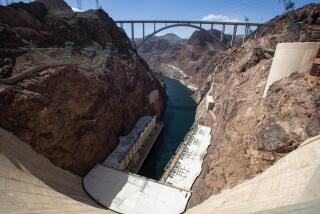L.A.’s DWP pays ‘significantly’ higher salaries, analysis finds
Salaries at the Los Angeles Department of Water and Power are “significantly” higher than those paid by other public and private utilities, according to an analysis prepared for city leaders.
With two back-to-back electricity rate increases — 4.9% this year and 6% next year — up for a City Council vote Tuesday, a Los Angeles-based consulting firm has concluded that key employee groups at the DWP earn more and receive health and retirement benefits that appear “more generous than industry norms.”
Those conclusions were contained in a 139-page report released last month on the DWP rate increases, which are expected to generate an extra $321 million by June 2014. PA Consulting, which prepared the report, endorsed the rate hikes but also informed the DWP that it needs to look seriously at cutting its personnel costs.
“The most immediate way” to reduce the size of future rate increases “will be to address the costs of running the system,” the firm said. “And to reduce these costs, the department needs to focus on the building block costs that drive them: labor costs, benefits and productivity.”
DWP officials contend that even if they secured a 10% across-the-board pay cut — something that couldn’t happen until its employee contract expires in two years — they would be able to trim only the size of rate hikes being considered for 2014, 2015 and 2016. They said the major cause of rate increases are state regulations, including those that call for cleaner-burning energy and greater pollution controls on electrical generation.
“Right now I’ve got a bunch of other things that have a lot higher priority in terms of saving hundreds of millions of dollars at Water and Power,” said Ron Nichols, the DWP’s top executive.
Ratepayers would see much greater savings, DWP officials said, if the utility focuses on energy efficiency — reducing electricity usage across the city — and by negotiating aggressively as it adds new sources of renewable energy, such as wind and solar power.
The DWP’s arguments have not convinced Councilman Bernard C. Parks, who said he will not vote for any new rate hikes until city leaders address the gap between salaries and benefits given at the DWP and those provided to other city workers.
“All of those issues have been brought up” before, Parks said. “It’s just that the council has had no will to deal with them.”
Andrew Rea, who helped prepare the PA Consulting report, said his firm made estimates of DWP salaries using a database from 2007 and cost-of-living increases promised in the utility’s employment contract through this year. Using that information, the firm said:
•Workers at DWP “contact centers” made an average of 20% more than their counterparts at 13 comparable utilities, including Southern California Edison and Southern California Gas Co.
•The average top salary for a groundman/utility worker at the DWP was 41% higher than the average top salary for that job at 15 other utilities.
•The average maximum salary for a DWP cable splicer was 43% higher than average maximum salaries paid at 15 other utilities.
•The average salary for a meter reader at the DWP was 46% higher than those employed by 13 comparable utilities.
“In the case of customer service positions, [the DWP] pays its employees on average 28% higher than all other utilities in the database — and 29% more than its closer peer utilities” — a group that includes Pasadena Water and Power, Pacific Gas and Electric and other California utilities, the report said.
The firm’s findings were dismissed by Brian D’Arcy, head of the International Brotherhood of Electrical Workers Local 18, which represents the vast majority of the DWP’s employees. D’Arcy accused PA Consulting of skewing its numbers and asserted that workers at private utilities get benefits that went unmentioned in the report.
“When you compare the whole package, it’s probably even,” he said.
DWP employees received pay raises in each of the last three years: 2% in 2010, 4% in 2011 and 2% again this year, according to the utility.
In its report, PA Consulting said it found “no evidence” that the DWP had pursued the types of cost-cutting measures sought by Mayor Antonio Villaraigosa and the council for the general fund budget, which pays for police officers and firefighters.
The rate hikes have won support from independent DWP ratepayer advocate Fred Pickel, who said the utility has gone too many years without the types of increases needed to repair its aging infrastructure. Although he agreed that employee costs are higher, he noted that they make up only one-fourth of the utility’s financial burden.
Pickel, who used PA’s numbers for his analysis, said the DWP should spend the next two years looking at ways of contracting out — hiring workers for less money to handle some of the utility’s jobs.
Villaraigosa said he saw no need to negotiate a new employee contract at the utility before he leaves office next June. He would not say if he was troubled by the salary findings contained in the report.
“What’s important is that PA Consulting and the ratepayer advocate have opined that a rate adjustment in these times makes sense,” he said.
More to Read
Start your day right
Sign up for Essential California for news, features and recommendations from the L.A. Times and beyond in your inbox six days a week.
You may occasionally receive promotional content from the Los Angeles Times.






